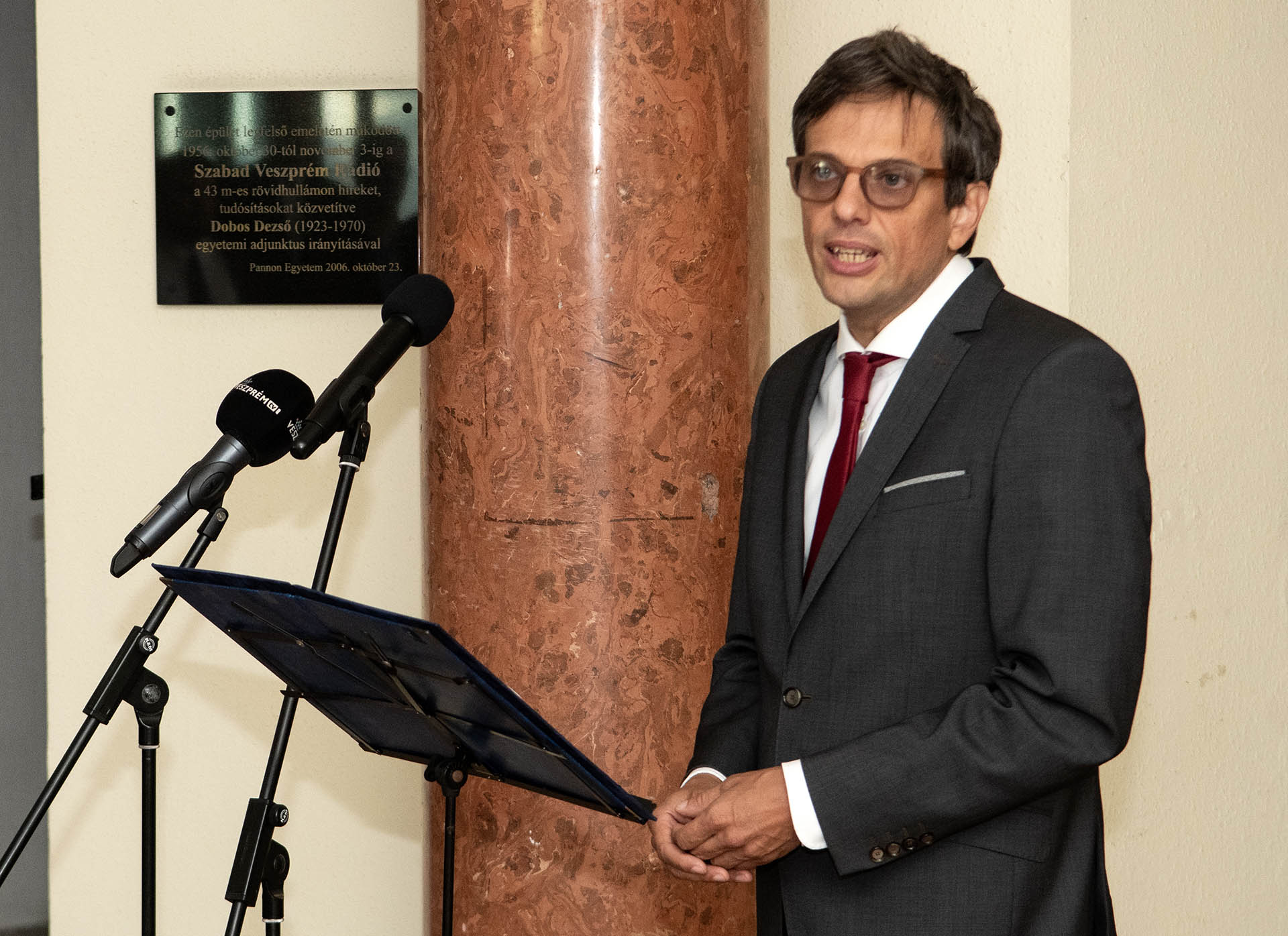Hallgatói portál
- fas fa-search
- Accessibility
Hallgatói portál
Rector János Abonyi commemorated the heroes of the 1956 Hungarian Revolution at the University of Pannonia with a ceremonial speech and wreath-laying.
Below is the full text of the Rector's speech.
And we stand tall, singing as we walk,
The word of freedom fills everything.
Our deadly, dreadful dream has ended,
And the tyrant’s star falls in the night.
In the autumn wind, the towers of Veszprém
Once again wave the Hungarian flag,
And as long as we live, until our blood turns to water,
The Hungarian flag will not be taken down.
Dear audience gathered in remembrance,
Dear university community,

The poem we just heard was the message that the youth of Veszprém sent to the youth of Budapest on October 26, 1956. I believe we all feel that this message is meant for us too. We have a duty to remember the history of the Veszprém University of Chemical Industry from 1956 every year because it bears witness to values that must also define the future of the successor institution, the University of Pannonia. These values are critical thinking, a sense of responsibility for future generations, and the courage to stand up for each other, for our broader environment, and for our country. To understand how these values emerged, let’s briefly review the sequence of university events during the 1956 revolution.
In the 1950s, everything had to follow the Soviet model. Since there was a higher education institution in Moscow that trained only chemical engineers, similar institutions were established in Bulgaria, Czechoslovakia, the GDR, and Hungary. Seventy-five years ago, on September 26, 1949, our institution’s predecessor began operations with 16 lecturers and 107 students.
Soviet ideology dominated education, scientific life, and even the daily lives of students. In response to this intellectual oppression and unjust practices, students from universities and colleges began to organize. They founded the Union of Hungarian University and College Students (MEFESZ), and student groups formed across the country, including in Veszprém.
It was the Veszprém MEFESZ that would later articulate the forward-looking demands that became the goals of the revolution. I will quote only the first of the 20 goals: “An independent, neutral Hungary, with its own national foreign policy and independent economic policy.”
The events of the revolution unfolded quickly, and each day offers us an example to follow:
October 15, the day of critical thinking:
The Patriotic People’s Front organized an intellectual meeting at the university's chamber hall with the participation of lecturers, during which criticisms of the party’s policies were voiced.
October 23, the first day of university solidarity:
Professor Pál Benedek assured the students of the University Council’s solidarity at a mass meeting held at the Petőfi Theater.
October 24, the day of courageous action for our environment:
Students distributed leaflets calling for action in surrounding towns. The university faculty declared the university’s autonomy.
October 27, the day of responsibility:
In the evening, a delegation led by Dr. Pál Benedek went to the nearby Soviet military airbase in Szentkirályszabadja, attempting to prevent the Soviet troops from launching an attack.
October 30, the day of social responsibility:
University students launched Radio Free Veszprém, broadcasting news in multiple languages.
October 31, the day of courage:
University students demanded weapons for themselves. Fortunately, the County Revolutionary Council rejected these demands, believing that the army, the police, and the newly formed National Guard units were sufficient to maintain order. No armed conflict developed in Veszprém.
November 4, the day of fighting spirit:
Outside Budapest, the largest street battles took place in Veszprém. The Soviets attacked simultaneously from the ground and air. The resistance lasted longest near Veszprém Castle due to its defensibility and the presence of university dormitories.
November 8, the day of great mental hardship:
Across the country, 860 people, including 90 from Veszprém—58 students and 3 lecturers—were deported to the Soviet Union.
The days that followed were marked by hope, the struggle for each other, and wise perseverance. Dean Károly Polinszky visited the Soviet military command at Ajtósi Dürer Street in Budapest twice, requesting information about the deportees. After failing to get results, he sent the list of deportees abroad to the UN. Thanks to his efforts, the deported individuals returned by December.
Of course, saving lives was an important achievement, but careers were ruined in the process. In Veszprém, 13 lecturers were dismissed, and 32 students were expelled or faced disciplinary action. Fifty-one Veszprém students and seven lecturers fled to the West, sympathizing with the revolution. Unfortunately, it took a long time for full rehabilitation. On October 29, 1991, those affected were ceremonially presented with personalized certificates of moral rehabilitation, which precisely named the injustices they had suffered. Our obligation to these great predecessors does not end with this gesture; it remains forever. Our duty is not only to remember these events every year but also to continue to uphold the values that characterized our students in 1956—values that are still very much needed today.
Please, let us not forget that these values are none other than:
Critical thinking,
A sense of responsibility for future generations,
And the courage to stand up for each other, our broader environment, and our country.
I ask you, if we ever feel uncertain, let the message of our 1956 students resonate in our ears:
In the autumn wind, the towers of Veszprém
Once again wave the Hungarian flag,
And as long as we live, until our blood turns to water,
The Hungarian flag will not be taken down.